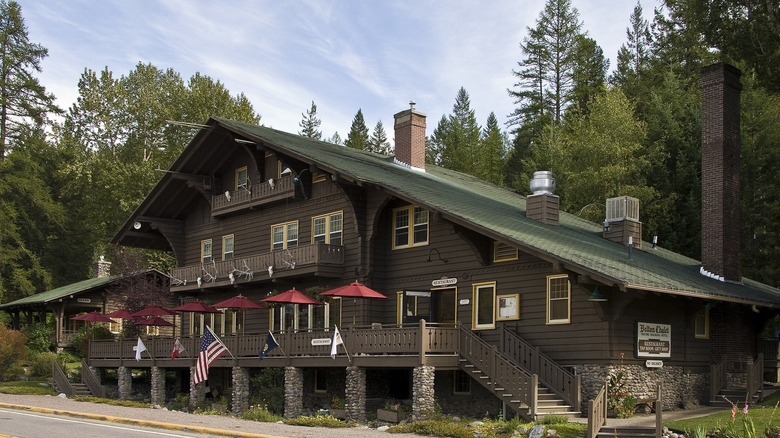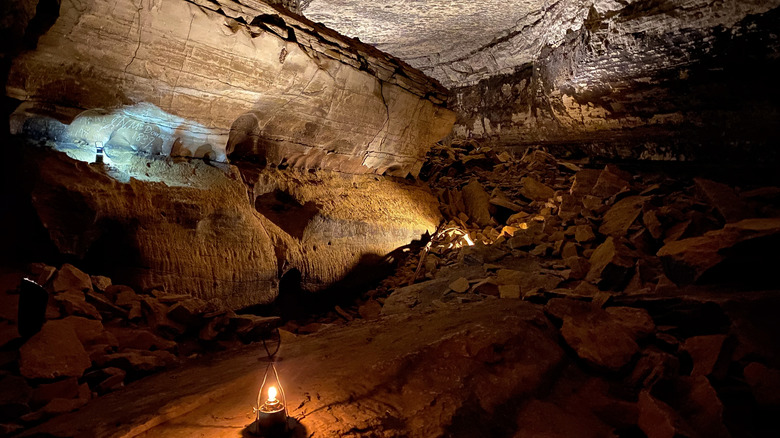Terrifying Stories From Inside America's National Parks
For many, many visitors, the U.S. National Park System (NPS) is a real wonder. It preserves 85 million acres of land, from historic sites to true wilderness — the largest one of all has over 13 million acres within its boundaries. With over 21,000 miles of trails alone, it's no wonder that the NPS is often considered a shining achievement of all those who made it happen.
But, while you very definitely should get to your closest national park and spend some time in nature, there is also a dark side to the NPS. With so many years in operation and thousands upon thousands of visitors, something scary is bound to happen every once in a while. From mysterious disappearances to adventurers who perhaps never left their beloved wilderness, there's quite a lot to dig into. So while you're planning your next hike and taking heed of things to not do in a national park, keep some of these terrifying stories in mind, whether they're for a fun scare, to bolster your respect for history, or remind you of the dangers of wilderness that are worthy of respect.
Glen and Bessie Hyde disappeared into Grand Canyon National Park
It must have seemed idyllic — two newlyweds off on an adventure together in the Grand Canyon. But braving the Colorado River is no easy feat now or back in 1928, when Glen and Bessie Hyde set off through a fairly new Grand Canyon National Park (established in 1919). While others had used rowboats, the Hydes intended to make their trip in a scow, a larger oared boat with a small sail. Glen was an experienced boater but Bessie lacked that skillset, though she would be the first woman to navigate the canyon by river.
They began their trip in Utah in October and interacted with a few people who confirmed their presence in the park. But then the Hydes vanished. Searchers found their scow, undamaged and full of supplies, but there was no sign of them. Soon, the Hydes had joined the ranks of mysterious vanishings within the Grand Canyon.
The most likely explanation: The couple went overboard. Given the rushing waters, vast canyon, and presence of scavenging animals, searchers might have never found remains. But that hasn't stopped a few wild stories, and some elderly women have even claimed to be Bessie herself (one colorfully claimed she killed Glen). In 1977, a skull with a bullet hole was found in the home of boater Emery Kolb, one of the last people to interact with the Hydes. Some speculated the skull was Glen's, but so far the evidence doesn't bear out, leaving the fate of the Hydes a haunting mystery.
Apostle Islands National Lakeshore may have a ghostly hermit
Apostle Islands National Lakeshore, on Lake Superior in Wisconsin, presents a chilling tale of a recluse, a murder, and perhaps even a ghostly curse. It starts with a man named William Wilson, though accounts of his saga were written long after his death. Some time in the mid-19th century, Wilson set up a bare little cabin on what's now called Hermit Island. Tales have swirled about what pushed him to such a lonely existence — a broken heart? A lost family? A fight with another man? But those sad stories didn't catch nearly as much attention as what was allegedly in Wilson's possession — silver coins. Some alleged that he had a small hoard of gold, too. When he was found dead at his cabin in 1861, his home in disarray, people concluded he had been murdered for his glittering stash. Or perhaps, as others guessed, he had gone into alcohol withdrawal and died in violent spasms.
There's a chilling addendum to Wilson's tale. Visitors to Hermit Island in the years since Wilson's end sometimes report odd goings-on, with hints that Wilson's spirit still walks the island. A quarry owner, Frederick Prentice, began taking stone from the island in the late 19th century, even building a mansion there. Some say the reclusive Wilson hated the bustle and effectively cursed the mansion, which not only drove away Prentice's new bride, but then crumbled into an undignified pile over the years.
Hallie Illingworth returned in chilling fashion in Olympic National Park
The waters of Lake Crescent in Olympic National Park are deep and cold. You might think it was the perfect spot to hide misdeeds, but the eerie reappearance of Hallie Illingworth proves that very wrong. She was the wife of Monty Illingworth of Port Angeles, Washington. But after their 1936 marriage, the couple began to argue almost constantly ... until Hallie disappeared in December 1937. Well, Monty said, Hallie had often threatened to leave. Perhaps she had finally made good on her word.
But then Hallie returned ... in a fashion. In July 1940, fisherman in Lake Crescent came across the body of a woman floating in the water. But this was no ordinary corpse, as much of it had turned to a waxy, soap-like substance via a process known as saponification. Though the face was degraded, other parts, along with her clothes, blankets, and ropes tied around her, remained largely intact. She was so well-preserved that officials conducted an autopsy, determining she had died by strangulation. More detective work based on a unique dental bridge finally identified the remains as those of Hallie, now also known as the Lady of the Lake.
Monty was convicted of second-degree murder in 1942. Though he received a life sentence, his behavior was deemed good enough for parole less than a decade later. After that, Monty disappeared from the record, but Hallie remains in the local imagination.
Glacier National Park has guests who perhaps never left
It may seem strange to think of a national park as haunted. With all those expanses of natural beauty, how could anyone ever come across a ghost? But some historic buildings in the national parks have garnered quite the spectral reputation over the decades, including the longstanding guest lodges available for booking in Montana's Glacier National Park. Admittedly, many of the stories have been passed on by word of mouth and aren't always easy to confirm in official records, but quite a few people seem to believe something spooky is going on. Workers on the nighttime shift at Lake McDonald Lodge have reportedly seen a spectral woman dressed in clothes of a bygone era, and on multiple occasions at that.
Meanwhile, the Belton Chalet is allegedly inhabited by a spirit now known rather warmly as "Bob," despite the fact that he is said to steal your room key and may also be one of the spirits supposedly responsible for moving other items or creating ghostly sounds from footsteps to disembodied screams. Others report that a man's spirit — some wonder if it could be Bob himself, or whoever he really was in life — is sometimes seen at the train depot in the western part of the park. Some theorize that perhaps, at some point after the Belton Train Depot first went up in 1910, Bob came into the park and seriously extended his stay.
What killed Sheila Kearns in Mount Rainier National Park?
Mount Rainier National Park is widely known as a beautiful place, and by all accounts, Sheila Kearns was excited to be working there in the park's Paradise Inn. She was even more excited when she was hired to continue working through the park's quiet winter season. But, just as that season was poised to start in early October 1996, Kearns failed to show up for work. It was a quandary for many of those who knew her, who told reporters that Kearns was a friendly, happy woman who had a reputation for treating both guests and co-workers with kindness. When her employers checked her room in on-site housing, they found nothing out of order — except for the fact that Kearns was nowhere to be found. Despite a three-day search, no trace of her was found until the next spring, when her remains were found at a nearby campground.
Though Kearns' physical remains were recovered and the FBI became involved, it's still unclear just what happened to her. Some have suggested that she had an accident or was attacked by a wild animal, while others wonder if a human was responsible for her end. But without more physical evidence, witness testimony, a confession, or some other clue, her death is still unsolved. For someone who seemed to have few, if any, enemies and who truly enjoyed her work in the park, Kearns' abrupt end remains deeply confusing.
Spearfinger allegedly stalks Great Smoky Mountains National Park
With a name like "Spearfinger," you're likely already terrified by this one, but there's more to this tale than just a moniker. The Cherokee people of Tennessee have told the legend of this shapeshifting, human-eating monster whose territory is said to include what's now part of Great Smoky Mountains National Park. Also known as U`tlûñ'tä, or "she has it sharp," Spearfinger sports a wickedly long index finger with a cutting edge. What's more, many retellings of the Spearfinger legend maintain that she has skin like stone, making her impervious to nearly any form of attack and intensely strong. Though she often takes the form of an old woman, Spearfinger has the ability to transform if doing so makes it easier for her to seize a victim. Indigenous people warned of Spearfinger even mimicking members of one's own family. In fact, she was even sometimes reported to take on a friendly form, walk right into a person's home, and steal away their liver without anyone noticing. Eventually, the victim would grow weak and fade away.
At least the legends indicate that Spearfinger may no longer be stalking Great Smoky Mountains National Park and the rest of the region. When indigenous people decided enough was enough, a group of warriors managed to trap her in a large pit. At first, their weapons struck only her impervious skin, but with the assistance of a chickadee, they realized her weak spot was in her spiky hand and struck her down.
Despite identification, remains found at Yosemite National Park are still confusing
In 1983, one family's trip to Yosemite National Park turned dark. While in Summit Meadow, they found the remains of a woman's arm. Five years later, other visitors found a skull, which was eventually linked to the arm. A forensic anthropologist was at least able to identify the deceased as female, but with so few other clues and practically no avenues of investigation, the case went cold almost immediately. Some investigators with the National Park Service wondered if serial killer Henry Lee Lucas was involved, but his desire to get special treatment via confessions undermines this theory (and some wonder if the serial killer version of him ever existed at all).
When Summit Meadow Jane Doe was identified, things got stranger. In 2021, genetic testing and forensic genealogy revealed the deceased to be Patricia "Patty" Hicks, originally from Spokane, Washington. After a divorce and still dealing with the sudden death of her brother, Hicks moved to Merced, California, not far from Yosemite. There, she became involved with a cult led by Donald Gibson. In 1981, Gibson was put on trial for abusing people in the cult, but he was released on bail and left town. He hasn't been heard from since. Hicks appears to have died in the park around 1982. Could a fugitive Gibson have had a hand in Hicks' end? Or was it Lucas, who provided details of the scene that few others knew? Or could Hicks have met another, unidentified end on her own?
The story of Floyd Collins still haunts Mammoth Cave
Today, you can visit Kentucky's Mammoth Cave National Park and go a cave tour with the full knowledge that you'll be fine so long as you stay with your group. Heed that last point, as Mammoth Cave is the longest known cave system in the world, with 426 miles of caverns and passageways to get lost in. Even if you don't get disoriented, the less-trafficked parts of the caves can be dangerous, as epitomized by the story of poor Floyd Collins.
Collins, a local farmer, had a side business as a cave explorer and proprietor of a tourist attraction on his property. Only, his spot was a bit of a dud because it was simply too inconvenient to get to. So, he entered into an agreement with another landowner to investigate the better-situated Sand Cave. But, upon first entering it in early 1925, Collins found the passages were perilously tight. Even worse, when he went to exit, his lantern went out and a rock came loose and trapped his leg.
After he spent a torturous 25 hours alone in the damp and dark, someone finally made contact with Collins. Over the next 17 days, rescuers attempted to save an ever-weakening Collins, and it became a lurid national news story. But despite all the effort of locals, the arrival of the National Guard, hordes of gawkers, and relentless press attention, Collins tragically died. His brother Homer told of the experience on the vaudeville circuit to raise money and finally exhume Floyd's remains, which they did in April 1925.
Indiana Dunes National Park is linked to a murder mystery
This tale of Indiana Dunes National Park all starts with Alice Gray, born a city girl in 1881 Chicago. But despite her urban upbringing, Gray wanted nothing more than to get away from it all and went off to an academic career in mathematics. Late in 1915, feeling increasingly unsatisfied, Gray left for the dunes. She lived there for the rest of her life in little more than a tent or shack, gaining interest for supposedly bathing in Lake Michigan sans clothes. Gray was called "Diana of the Dunes," after the Roman goddess of the wilderness and hunting. She began to advocate for protecting her beloved dunes as they came under threat from encroaching settlement.
Then, Paul Wilson entered the story. He was a bit rough around the edges and allegedly stole food and supplies from Gray's neighbors. He was imprisoned for that in 1919, but returned to Gray and a seemingly quiet life on the dunes. Then, in 1922, they were accused of involvement in the nearby murder of an unidentified man, though Wilson was cleared of suspicion. When they confronted a sheriff's deputy about this and other accusations, the deputy struck Gray in the head so hard she was hospitalized.
When Gray recovered, the two returned to the dunes. Gray died in February 1925 of kidney failure. Legend has it that something of Gray really did stick around her beloved dunes. Visitors to the park have reported seeing a female figure that could be the long-gone Gray, sometimes taking another swim in the lake.
Edgar Watson allegedly wreaked havoc in what's now Everglades National Park
The gloriously wild expanse of Everglades National Park preserves 1.5 million acres of habitat and includes key portions of the state's increasingly endangered freshwater wetlands. Only, legend has it that, prior to the Everglades officially becoming a national park, it was home to a killer.
It centers on the Ten Thousand Islands, a scattering of dry land amidst shallow water and mangroves, of which some parts are in Everglades National Park. As the legend goes, this is where Edgar Watson fled in the late 19th century after wreaking havoc in the Wild West. While some reportedly found the new homesteader charming, others alleged that Watson had a murdering streak that took the lives of hired farmhands, local officials, runaways, and a local couple. By 1910, Watson even said that he had apprehended Leslie Cox, his farm foreman, for the murders and killed the other man ... only, he had no body to produce. A local posse attempted to arrest Watson, but he was felled by the vigilantes' guns after his own shotgun jammed.
The Watson story should be taken with a hearty dose of skepticism. We certainly know he existed, but was he really a serial killer of the Everglades? Well, maybe — Watson does show up in court records for killing people, though he kept getting acquitted. No one can confirm the lurid tales, but the thought of them being true is still chilling.
Ranger Paul Fugate's disappearance still troubles Chiricahua National Monument
Perhaps being a ranger didn't pan out as a dream job for Paul Fugate, a monument naturalist at Chiricahua National Monument in Arizona. Fugate had something of a tense relationship with the NPS. Yet, when he was fired from Chiricahua National Monument, he successfully sued to regain his job, perhaps because he loved the landscape as much as any rule-follower. In January 1980, he set off for what should have been a quick hike but never returned. A friend reported his disappearance, and rangers began a nighttime search. That stretched into two weeks and included the help of a local rescue group and a National Guard helicopter. They found no trace of Fugate.
With no remains, Fugate was actually fired again for abandoning his post, which denied benefits to his wife, Dody. Besides the grind of government bureaucracy, the Fugate case has been subject to all manner of theories. Dody hired a psychic who claimed to detect a "time portal" that allowed her to see an incident where Fugate was apparently involved in a crime, perhaps as a witness. Others have noted the increasing presence of smugglers and traffickers in the region at that time, subsequently wondering if the missing ranger was involved in something illegal or, more innocently, came across the wrong people at the wrong time. But with no remains and little evidence, at least as far as the public is concerned, Fugate's disappearance remains one of the biggest missing-hiker stories of the last 50 years.











